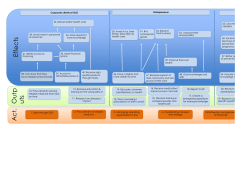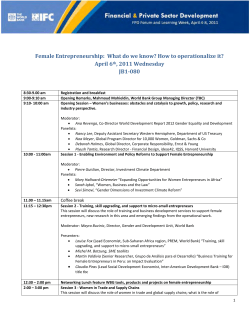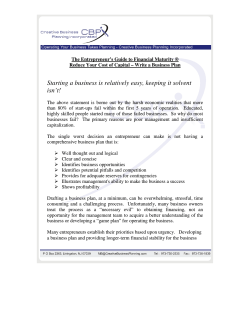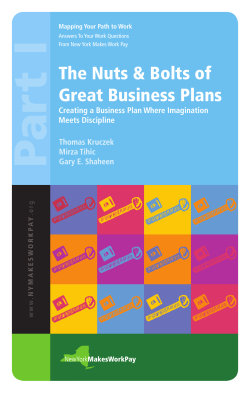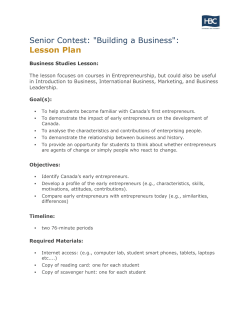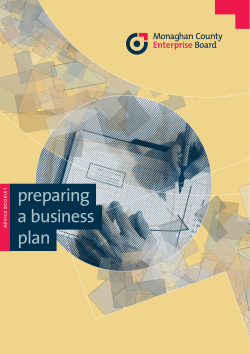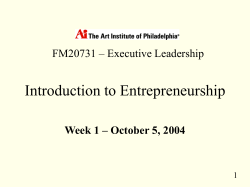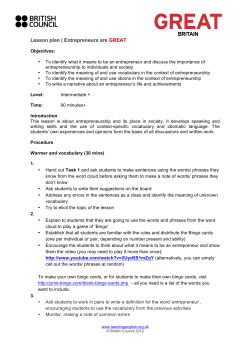
Writing a Business Plan
Writing a Business Plan This is the Business Plan template is designed by Business Partners. The aim is to build a well-motivated business plan from which a thorough understanding of your existing or proposed business, your own goals and objectives and your financing requirements can be obtained. Specific attention should be given to four key areas: 1. the business itself 2. the management of the business (the entrepreneurs involved) 3. the market in which the business operates 4. the financial management and planning - the risks and rewards associated with the total investment in the business. NOTE: Although a guide to writing a business plan is being made available here, circumstances vary considerably and you will need to tailor your business plan depending on the type of business — technology, manufacturing, service or retail. But, the basics remain the same. Every business plan should comprise the following sections: Cover page Executive summary Business overview — business profile — the product or service Management — the entrepreneurs — the management structure The Market — industry analysis — market analysis Sales and Marketing strategy Financial statements and projections Legal and regulatory environment SWOT analysis and risk/reward assessment Appendices and supporting documentation EXECUTIVE SUMMARY The executive summary is the MOST vital part of the business plan — it has to sell your strategy for success to the investor. The summary is an overview of the entire plan and must contain the highlights of the business plan and summaries of each section. Therefore, although it is at the beginning of the document, it is usually written last to capture the essence of the plan. The summary stands alone and should not refer to other parts of your document. BUSINESS OVERVIEW 1. Write a business profile, including the following: • information on the background and history of the business • indicate the business form (proprietorship, Close Corporation, Company) • Is it a new business, take over, expansion, franchise? • The mission, and the company's long and short term objectives in terms of business growth and development, as well possible exit strategies (for example: buy out investors, sell to larger company, go public, etc) 2. The product or service • describe in full the product or services offered by the business and the innovative features of these products and services and the competitive edge they afford the business over rivals in the market. • the expected product life cycle where applicable • include descriptions of key technologies employed and current and future research and development 3. Describe the location, premises and — where applicable — production facilities 4. Production and technology • describe production processes and capacity, identifying any existing constraints and possible problem areas • include a detailed analysis of the process of installing and commissioning any new technologies and production processes • include information on quality assurance systems and procedures, and certification • details of suppliers and sub-contractors, and any contractual arrangements governing the supply of key inputs 5. Elaborate on the business's past achievements and strengths and past problems and weaknesses, and critical success factors COMPANY MANAGEMENT 1. The entrepreneurs • include a description of the skills and experience of the entrepreneurs covering the key areas of technology and product development, production, sales, marketing, finance and administration • describe the position and the specific functions and responsibilities of each entrepreneur and/or manager • attach a detailed curriculum vitae of each entrepreneur • indicate the financial contribution of each entrepreneur to the business, and the current shareholding structure. 2. The management structure of the business • show company ownership structure, business units and subsidiaries where applicable • attach an organisation chart showing the functions and responsibilities of directors, key management and staff • formulate remuneration, incentives, share options, and conditions of employment of key management and directors • analyse of any deficiencies in management and how these positions are to be filled • comment on current and future employment levels, labour relations and union membership • include details of systems to be implemented: information technology, accounting, administration, management information and stock control systems • include details of auditors, attorneys, bankers and professional advisers 3. Franchise information (where applicable) If the business is a franchise, include what is covered in the management package the franchisor provides in this section THE MARKET 1. Industry analysis Summarise the industry in which you will compete. Find most of the facts from government statistics and trade organisations. Discuss topics such as: • current trends and developments in the industry • large and important players in the industry • how the industry is segmented • problems the industry might be experiencing • national or global events influencing the industry • national and global growth forecasts • how legislation affects the industry (for example, how the law limiting smoking in a restaurant affects the industry) 2. Market analysis • describe the existing market and its potential for growth • include a detailed analysis of the size and maturity of the market, trends and seasonality exhibited by the market, and the business's current and expected market share together with an analysis of the time, resources and actions required to achieve this desired market share • list existing and potential customers, supported by letters of intent, orders on hand, contracts, where applicable • include a detailed analysis of competitors, the price and quality of their products, service and delivery, and their expected reaction to your activities • highlight and discuss your competitive advantage SALES AND MARKETING STRATEGY 1. elaborate on current and planned sales and marketing strategies and promotional activities (advertising, exhibitions, promotions, public relations, etc.) 2. describe your distribution strategy and channels 3. formulate sales staffing, recruitment, remuneration and commission structures 4. include a detailed motivation and substantiation of sales projections (in monetary and physical terms) with a comprehensive analysis of the lead time expected to reach sales targets and milestones (e.g. break-even point) 5. elaborate on your pricing strategy and how it compares with your competition 6. where the business is a franchise, include the full marketing strategy of the franchisor FINANCIAL STATEMENTS AND PROJECTIONS **Note: to view the examples below you must have Acrobat Reader installed on your system. Click on the link for a free download http://www.adobe.com/products/acrobat/readstep.html http://www.adobe.com/products/acrobat/readstep.html 1. Include only a summary of the financial statements and projections in the body of the business plan — attached detailed analysis as an appendix 2. Include operating budgets, cash flow projections (click here to see example of cash flow statement), income statements (click here to see example of income statement) and pro forma balance sheets (click here to see example of balance sheet) for at least three years (recommended five years). Provide monthly projected figures for the first and second year, quarterly figures for years three and four and annual projections thereafter. 3. Where applicable, provide: • historical financial performance as shown by at least the last three sets of audited annual financial statements and up to date management accounts comprising income statements (monthly and year-todate), balance sheets, and debtors and creditors age analysis • costing methodology employed, or to be employed, and detailed costings giving a full analysis of cost of sales • pricing policies giving a full analysis of theoretical and actual mark up and gross profit percentages • rebates, discount structures and terms offered to and received from costumers and suppliers respectively • break-even and sensitivity analysis • details of overdraft and factoring facilities (bank, limit, security and interest rate) and medium and long term loans 4. Ensure that your financial projections agree with any other statements in the business plan (for example, costs involved in your proposed marketing strategy) 5. Formulate and motivate your capital requirements LEGAL AND REGULATORY ENVIRONMENT Include: • details of any licences, copyrights, trademarks and patents registered (or in the process of being registered) • details of any legislation and regulations governing the industry, product and production processes • proof of compliance with tax and labour legislation (VAT, PAYE, RSC, UIF, COIDA, Employment Equity Act, Skills Development Act, etc) where applicable • details of duties and tariffs to which inputs or products are subject if the business is a regular importer or exporter SWOT ANALYSIS AND RISK/REWARD ASSESSMENT 1. Discuss definite and possible strengths, weaknesses, opportunities and threats 2. Give an honest assessment of the risks faced by the business, entrepreneurs and investors in relation to the potential for growth, profitability, and capital appreciation 3. Discuss strategies that can be implemented to address the risk factors highlighted APPENDICES AND SUPPORTING DOCUMENTATION The following supporting documentation, inter alia, should be included where applicable: • newspaper clippings, promotional literature, product brochures, market research, trade and industry publications • partnership, association or shareholders' agreements • offers to purchase, purchase and sale agreements • contracts, orders, letters of intent • memoranda of understanding, lease, franchise, agency or distribution agreements • documentation relating to licences, copyrights, trademarks and patents • quotations or pro-forma invoices for capital items to be purchased • detailed personal balance sheets of the entrepreneurs • copies of identity documents and marriage certificates of the entrepreneurs • schedules of life assurance and endowment policies of the entrepreneurs • copies of company or close corporation certificates and registration documents • drawings, work flow charts, plans, factory layouts, maps, etc • a list of persons to whom reference can be made regarding creditworthiness, product and service quality, and the skills, abilities and integrity of the entrepreneurs
© Copyright 2025




